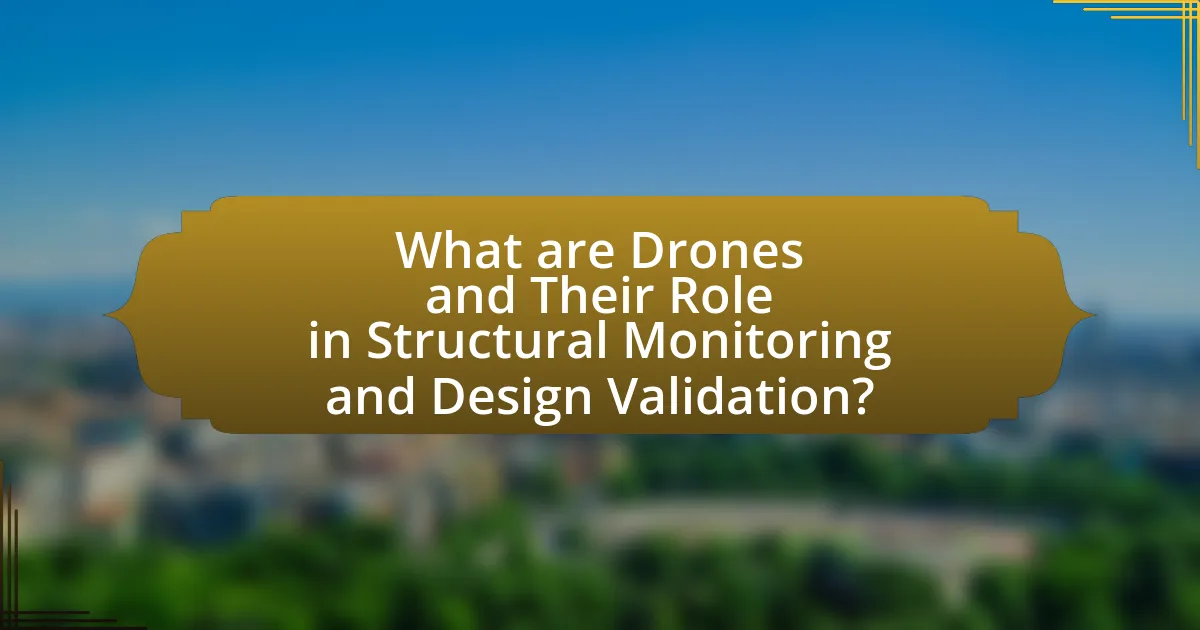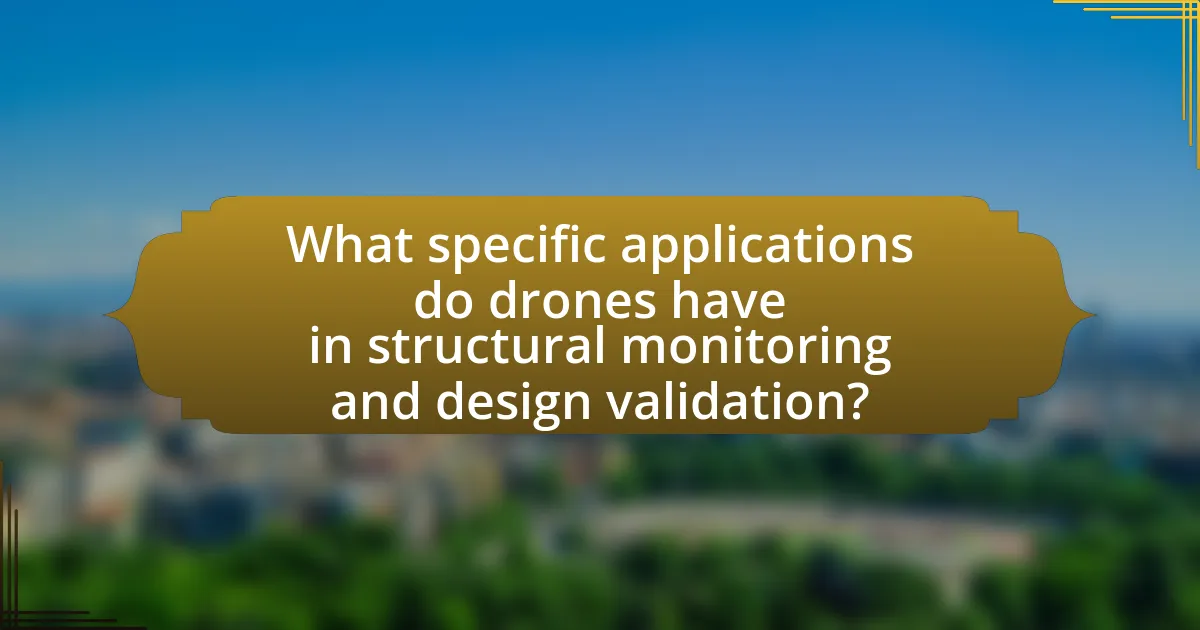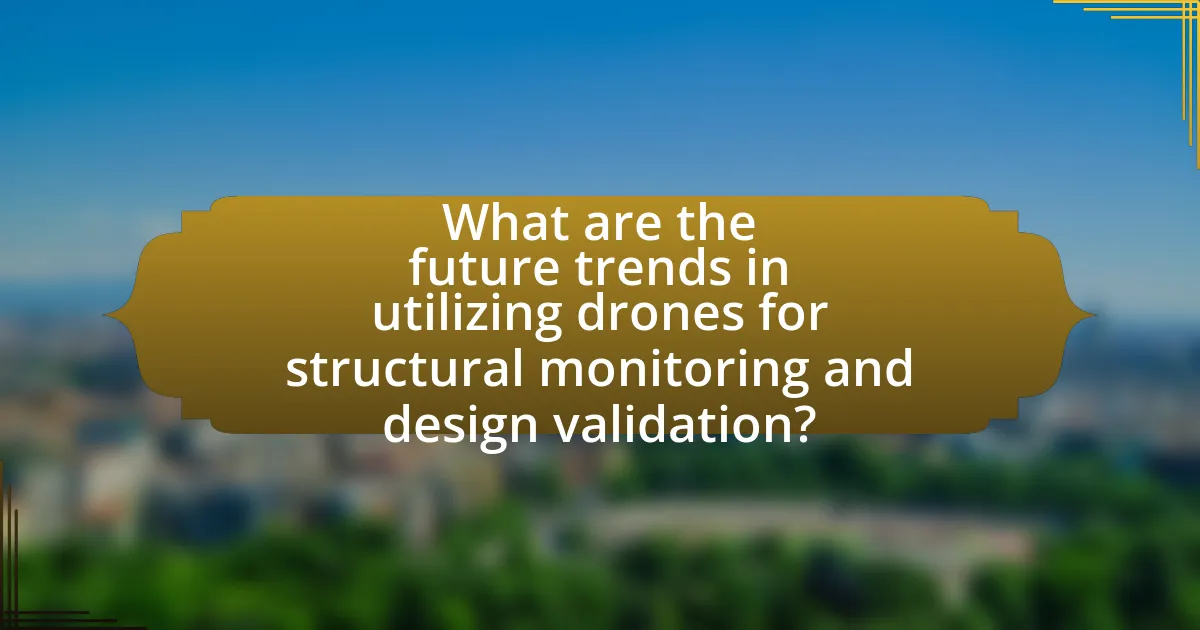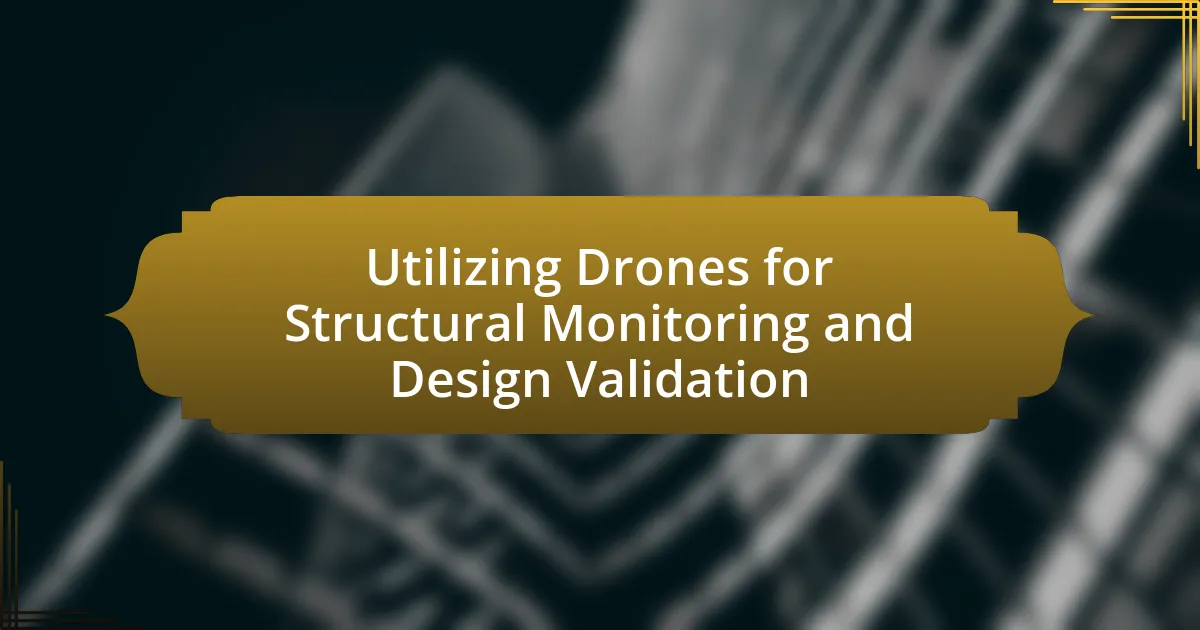Drones, or unmanned aerial vehicles, are increasingly utilized in structural monitoring and design validation due to their ability to efficiently collect and analyze data on infrastructure such as bridges and buildings. Equipped with advanced sensors and imaging technologies, drones enhance the accuracy and speed of inspections, reducing inspection times by up to 80% compared to traditional methods. This article explores the various technologies that enable drones to assess structural integrity, the importance of structural monitoring in construction and engineering, and the significant advantages drones offer over conventional monitoring techniques. Additionally, it addresses the challenges of drone implementation, best practices for compliance with safety regulations, and future trends in drone technology for structural assessments.

What are Drones and Their Role in Structural Monitoring and Design Validation?
Drones are unmanned aerial vehicles equipped with sensors and cameras that play a crucial role in structural monitoring and design validation. They enable efficient data collection and analysis of structures, such as bridges and buildings, by providing high-resolution imagery and real-time monitoring capabilities. For instance, a study published in the Journal of Civil Engineering and Management demonstrated that drones can reduce inspection time by up to 80% compared to traditional methods, while also enhancing safety by minimizing the need for human inspectors to access hazardous areas. This technology allows for precise assessments of structural integrity, facilitating timely maintenance and ensuring compliance with design specifications.
How do drones function in the context of structural monitoring?
Drones function in structural monitoring by providing aerial data collection and analysis capabilities that enhance the assessment of infrastructure integrity. Equipped with high-resolution cameras, LiDAR, and thermal imaging sensors, drones can capture detailed images and measurements of structures, allowing for real-time monitoring and inspection. This technology enables the identification of potential issues such as cracks, corrosion, or structural deformities, which can be difficult to detect from the ground. Studies have shown that using drones can reduce inspection time by up to 80% compared to traditional methods, while also minimizing safety risks for personnel.
What technologies enable drones to perform structural assessments?
Drones utilize several key technologies to perform structural assessments, including high-resolution cameras, LiDAR (Light Detection and Ranging), thermal imaging, and GPS (Global Positioning System). High-resolution cameras capture detailed images of structures, allowing for visual inspections and identification of surface defects. LiDAR technology enables drones to create precise 3D models of structures by measuring distances with laser pulses, which is essential for assessing structural integrity. Thermal imaging detects temperature variations, helping to identify issues such as insulation failures or moisture intrusion. GPS technology provides accurate positioning data, ensuring that assessments are conducted at specific locations and enabling the integration of data into geographic information systems (GIS) for further analysis. These technologies collectively enhance the efficiency and accuracy of structural assessments conducted by drones.
How do drones collect data for design validation?
Drones collect data for design validation by utilizing advanced sensors and imaging technologies to capture high-resolution aerial imagery and 3D models of structures. These drones are equipped with LiDAR, photogrammetry cameras, and thermal imaging sensors, which allow them to gather precise measurements and detect anomalies in structural integrity. For instance, a study by the National Institute of Standards and Technology demonstrated that drones can achieve accuracy levels within a few centimeters when mapping structures, making them effective tools for validating design specifications against actual conditions. This data is then analyzed to assess compliance with design parameters, ensuring that structures meet safety and performance standards.
Why is structural monitoring important in construction and engineering?
Structural monitoring is crucial in construction and engineering because it ensures the safety, integrity, and longevity of structures. By continuously assessing the condition of buildings and infrastructure, engineers can detect potential issues such as material fatigue, structural deformation, or environmental impacts before they lead to failures. For instance, a study published in the Journal of Structural Engineering found that implementing regular monitoring can reduce maintenance costs by up to 30% and extend the lifespan of structures by identifying problems early. This proactive approach not only enhances safety but also optimizes resource allocation and project management in construction and engineering projects.
What are the risks of neglecting structural monitoring?
Neglecting structural monitoring poses significant risks, including undetected structural failures, increased safety hazards, and costly repairs. Without regular monitoring, critical issues such as material degradation, stress fractures, or design flaws may go unnoticed, leading to catastrophic failures. For instance, the collapse of the Morandi Bridge in Italy in 2018, which resulted in 43 fatalities, was attributed to a lack of adequate monitoring and maintenance. Additionally, neglecting structural monitoring can lead to regulatory non-compliance, resulting in legal repercussions and financial penalties. Overall, the absence of structural monitoring compromises safety, increases long-term costs, and can have dire consequences for both human life and infrastructure integrity.
How does effective monitoring contribute to safety and compliance?
Effective monitoring enhances safety and compliance by providing real-time data that identifies potential hazards and ensures adherence to regulations. Drones, utilized for structural monitoring, can quickly assess conditions and detect issues such as structural weaknesses or environmental hazards, which traditional methods may overlook. For instance, a study by the Federal Aviation Administration (FAA) indicates that drone inspections can reduce the time needed for assessments by up to 80%, allowing for timely interventions that prevent accidents and ensure compliance with safety standards. This proactive approach not only mitigates risks but also fosters a culture of accountability and transparency in safety practices.
What advantages do drones offer over traditional monitoring methods?
Drones offer significant advantages over traditional monitoring methods, primarily through enhanced efficiency, cost-effectiveness, and improved data accuracy. Drones can cover large areas quickly, reducing the time required for inspections compared to manual methods, which often involve labor-intensive processes. For instance, a drone can inspect a bridge in a fraction of the time it would take a team of workers, allowing for more frequent assessments and timely maintenance.
Additionally, drones are equipped with advanced sensors and cameras that capture high-resolution images and data, leading to more precise measurements and insights. This technological capability enables the identification of structural issues that might be missed during conventional inspections. According to a study by the Federal Aviation Administration, drones can reduce inspection costs by up to 30% while increasing the frequency of monitoring, thereby enhancing overall safety and reliability in structural assessments.
How do drones improve efficiency in data collection?
Drones improve efficiency in data collection by enabling rapid, high-resolution aerial surveys that cover large areas in a fraction of the time required by traditional methods. For instance, drones can capture detailed images and data from hard-to-reach locations, reducing the need for manual inspections and minimizing human labor costs. Studies have shown that using drones can increase data collection speed by up to 80% compared to ground-based methods, while also enhancing data accuracy through advanced imaging technologies such as LiDAR and photogrammetry. This efficiency not only accelerates project timelines but also allows for more frequent data updates, leading to better-informed decision-making in structural monitoring and design validation.
What cost savings can be achieved through drone utilization?
Drone utilization can achieve significant cost savings by reducing labor expenses, minimizing material waste, and enhancing operational efficiency. For instance, drones can perform inspections and surveys in a fraction of the time it takes traditional methods, leading to labor cost reductions of up to 50%. Additionally, drones can identify structural issues early, preventing costly repairs and minimizing material waste by ensuring that only necessary resources are used. A study by the Association for Unmanned Vehicle Systems International found that companies using drones for inspections reported a 70% reduction in inspection costs compared to conventional methods. This demonstrates that integrating drones into structural monitoring and design validation can lead to substantial financial benefits.
How can drones be integrated into existing structural monitoring practices?
Drones can be integrated into existing structural monitoring practices by utilizing their aerial capabilities to conduct inspections and gather data on structures efficiently. This integration allows for real-time monitoring and assessment of structural integrity, reducing the need for manual inspections that can be time-consuming and hazardous. For instance, drones equipped with high-resolution cameras and sensors can capture detailed images and data of hard-to-reach areas, enabling engineers to identify potential issues such as cracks or corrosion. Studies have shown that using drones can reduce inspection times by up to 80% compared to traditional methods, thereby enhancing safety and operational efficiency in structural monitoring.
What are the challenges of using drones for structural monitoring?
The challenges of using drones for structural monitoring include regulatory restrictions, technical limitations, and data processing complexities. Regulatory restrictions often hinder drone operations, as many regions have strict laws governing airspace usage, which can limit access to certain areas. Technical limitations arise from factors such as battery life, payload capacity, and the need for advanced sensors to capture high-quality data. Data processing complexities involve the need for specialized software and expertise to analyze the large volumes of data collected, which can be time-consuming and resource-intensive. These challenges can impede the effectiveness and efficiency of drone-based structural monitoring initiatives.

What specific applications do drones have in structural monitoring and design validation?
Drones are utilized in structural monitoring and design validation for applications such as visual inspections, data collection, and 3D modeling. These unmanned aerial vehicles can capture high-resolution images and videos of structures, allowing for detailed assessments of conditions without the need for scaffolding or ladders. For instance, drones equipped with thermal imaging cameras can detect heat loss or moisture intrusion in buildings, providing critical data for maintenance and repair decisions. Additionally, drones can create accurate 3D models and maps of structures, which are essential for validating design specifications and ensuring compliance with engineering standards. The use of drones in these applications enhances efficiency, reduces costs, and improves safety by minimizing the need for human presence in potentially hazardous environments.
How are drones used in the inspection of bridges and buildings?
Drones are utilized in the inspection of bridges and buildings by providing aerial imagery and data collection that enhances safety and efficiency. These unmanned aerial vehicles can access hard-to-reach areas, allowing inspectors to gather high-resolution images and videos, which facilitate the identification of structural issues such as cracks, corrosion, and other forms of deterioration. For instance, a study by the Federal Aviation Administration (FAA) highlighted that drones can reduce inspection time by up to 80% compared to traditional methods, while also minimizing the risks associated with working at heights. This capability not only streamlines the inspection process but also improves the accuracy of assessments, leading to better maintenance and safety outcomes for infrastructure.
What specific features do drones assess during inspections?
Drones assess several specific features during inspections, including structural integrity, surface conditions, thermal anomalies, and vegetation encroachment. These features are evaluated through high-resolution imaging, thermal imaging, and LiDAR technology, which allow for detailed analysis of buildings, bridges, and other structures. For instance, drones can detect cracks, corrosion, and other signs of wear that may not be visible from the ground. Additionally, thermal imaging can identify heat loss or insulation issues, while LiDAR can create precise 3D models of structures for further analysis. This capability enhances safety and efficiency in inspections, reducing the need for manual assessments in hazardous environments.
How do drones facilitate real-time monitoring of structural integrity?
Drones facilitate real-time monitoring of structural integrity by providing high-resolution aerial imagery and data collection capabilities. Equipped with advanced sensors, drones can capture detailed visual and thermal images, enabling the identification of structural defects such as cracks, corrosion, and material degradation. For instance, a study published in the Journal of Civil Structural Health Monitoring demonstrated that drones equipped with thermal imaging cameras could detect temperature anomalies in bridges, indicating potential structural issues. This capability allows for timely interventions and maintenance, ultimately enhancing safety and reducing costs associated with traditional inspection methods.
What role do drones play in the validation of design plans?
Drones play a critical role in the validation of design plans by providing high-resolution aerial imagery and data collection that enhances accuracy and efficiency in monitoring construction progress. These unmanned aerial vehicles can quickly survey large areas, capturing detailed visual and thermal data that allows for real-time assessment of structural integrity and compliance with design specifications. For instance, a study by the National Institute of Standards and Technology found that drones can reduce the time required for site inspections by up to 75%, while also increasing the precision of measurements taken during the validation process. This capability enables project managers to identify discrepancies between the actual construction and the design plans, facilitating timely adjustments and ensuring adherence to safety and quality standards.
How can drones assist in verifying compliance with design specifications?
Drones assist in verifying compliance with design specifications by providing high-resolution aerial imagery and precise measurements of structures. These unmanned aerial vehicles can capture detailed visual data that allows engineers and inspectors to assess whether construction aligns with the approved plans. For instance, drones equipped with LiDAR technology can generate accurate 3D models of structures, enabling comparisons against design specifications. Studies have shown that using drones can reduce inspection time by up to 75% while increasing data accuracy, thus ensuring compliance with safety and design standards.
What data analysis techniques are used in conjunction with drone-collected data?
Data analysis techniques used in conjunction with drone-collected data include photogrammetry, LiDAR analysis, and machine learning algorithms. Photogrammetry allows for the creation of 3D models and maps from aerial images, enabling precise measurements and assessments of structures. LiDAR analysis provides high-resolution topographical data, which is essential for detecting structural anomalies and changes over time. Machine learning algorithms can process large datasets to identify patterns and predict structural behavior, enhancing monitoring and validation processes. These techniques are validated by their widespread application in civil engineering and environmental monitoring, demonstrating their effectiveness in analyzing drone-collected data.
What industries are most impacted by drone technology in structural monitoring?
The industries most impacted by drone technology in structural monitoring are construction, energy, and transportation. In construction, drones facilitate real-time site inspections and progress tracking, enhancing safety and efficiency. In the energy sector, particularly in wind and solar, drones are used for inspecting infrastructure, which reduces downtime and maintenance costs. The transportation industry benefits from drone technology through the monitoring of bridges and railways, allowing for timely maintenance and ensuring safety compliance. These applications demonstrate the significant influence of drone technology across these critical sectors.
How do construction companies benefit from drone technology?
Construction companies benefit from drone technology by enhancing project efficiency, improving safety, and providing accurate data for structural monitoring and design validation. Drones enable real-time aerial surveys, which can reduce the time required for site assessments by up to 75%, allowing for quicker decision-making and project timelines. Additionally, drones can access hard-to-reach areas, minimizing the risk of accidents associated with traditional surveying methods. The data collected by drones, including high-resolution images and 3D models, supports precise monitoring of construction progress and compliance with design specifications, ultimately leading to cost savings and improved project outcomes.
What is the impact of drones on infrastructure management?
Drones significantly enhance infrastructure management by providing efficient data collection, monitoring, and inspection capabilities. They enable real-time aerial surveys, which improve the accuracy of assessments and reduce the time required for inspections compared to traditional methods. For instance, a study by the Federal Aviation Administration (FAA) indicates that drone inspections can be completed in a fraction of the time it takes for ground-based inspections, leading to cost savings and increased safety for workers. Additionally, drones equipped with advanced sensors can detect structural anomalies, such as cracks or corrosion, allowing for proactive maintenance and reducing the risk of catastrophic failures. This integration of drone technology into infrastructure management not only streamlines processes but also enhances the overall reliability and safety of infrastructure systems.

What are the future trends in utilizing drones for structural monitoring and design validation?
Future trends in utilizing drones for structural monitoring and design validation include increased automation, enhanced data analytics, and integration with artificial intelligence. Automation will streamline data collection processes, allowing drones to perform routine inspections autonomously, which improves efficiency and reduces human error. Enhanced data analytics will enable the processing of large datasets captured by drones, providing actionable insights for structural integrity assessments. Integration with artificial intelligence will facilitate real-time decision-making and predictive maintenance by analyzing patterns and anomalies in structural data. These trends are supported by advancements in drone technology, such as improved sensors and longer flight times, which enhance the capabilities of drones in monitoring and validating structural designs.
How is technology evolving to enhance drone capabilities in this field?
Technology is evolving to enhance drone capabilities in structural monitoring and design validation through advancements in sensors, artificial intelligence, and data analytics. These improvements allow drones to capture high-resolution imagery and detailed structural data, enabling precise assessments of infrastructure conditions. For instance, LiDAR technology integrated into drones provides accurate 3D mapping, which is crucial for identifying structural anomalies. Additionally, machine learning algorithms analyze the collected data to predict maintenance needs and optimize design processes, significantly improving efficiency and accuracy in monitoring tasks.
What advancements in AI and machine learning are influencing drone applications?
Advancements in AI and machine learning significantly influence drone applications by enhancing autonomous navigation, real-time data processing, and predictive analytics. For instance, deep learning algorithms enable drones to recognize and classify structural anomalies during inspections, improving the accuracy of monitoring tasks. Additionally, reinforcement learning techniques allow drones to optimize flight paths in complex environments, increasing efficiency in data collection. Research from the Journal of Field Robotics indicates that integrating AI-driven image analysis can reduce inspection times by up to 50%, demonstrating the tangible benefits of these technologies in structural monitoring and design validation.
How might regulatory changes affect the use of drones in structural monitoring?
Regulatory changes can significantly impact the use of drones in structural monitoring by altering operational guidelines, safety standards, and permissible flight zones. For instance, stricter regulations may limit the altitude at which drones can operate or impose additional certification requirements for operators, thereby affecting the frequency and scope of inspections. In the United States, the Federal Aviation Administration (FAA) has implemented regulations that require remote pilots to obtain a Part 107 certification, which directly influences the accessibility and deployment of drones for structural monitoring tasks. Such changes can lead to increased operational costs and longer project timelines, as compliance with new regulations may necessitate additional training and equipment modifications.
What best practices should be followed when implementing drones for structural monitoring?
Best practices for implementing drones for structural monitoring include ensuring regulatory compliance, selecting appropriate drone technology, and conducting thorough pre-flight planning. Regulatory compliance is essential as it ensures adherence to aviation laws and safety standards, which vary by region. Selecting the right drone technology involves considering factors such as payload capacity, flight time, and sensor capabilities, which directly impact data quality and monitoring effectiveness. Thorough pre-flight planning includes assessing environmental conditions, defining flight paths, and ensuring equipment readiness, which minimizes risks and enhances data collection accuracy. These practices are supported by industry standards and guidelines from organizations such as the Federal Aviation Administration (FAA) and the International Organization for Standardization (ISO), which emphasize safety and operational efficiency in drone operations.
How can organizations ensure compliance with safety regulations when using drones?
Organizations can ensure compliance with safety regulations when using drones by implementing a comprehensive safety management system that includes training, risk assessment, and adherence to regulatory guidelines. This system should involve regular training for drone operators on current regulations set by authorities such as the Federal Aviation Administration (FAA) in the United States, which mandates specific operational procedures and safety protocols. Additionally, organizations must conduct thorough risk assessments before each flight to identify potential hazards and mitigate them effectively. Compliance can be further reinforced by maintaining accurate records of all drone operations, including flight logs and maintenance checks, which are essential for demonstrating adherence to safety standards.
What training is necessary for personnel operating drones in structural assessments?
Personnel operating drones in structural assessments require specialized training that includes understanding drone operation, safety protocols, and data analysis. This training typically encompasses obtaining a Remote Pilot Certificate from the Federal Aviation Administration (FAA) in the United States, which ensures that operators are knowledgeable about airspace regulations, weather conditions, and emergency procedures. Additionally, training in the use of specific drone technology, such as photogrammetry and LiDAR, is essential for accurately capturing structural data.
Furthermore, personnel should receive instruction on interpreting the data collected, which may involve training in software tools used for analysis and reporting. This comprehensive training ensures that operators can effectively assess structural integrity and contribute to maintenance and safety evaluations.

Leave a Reply